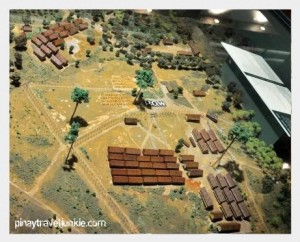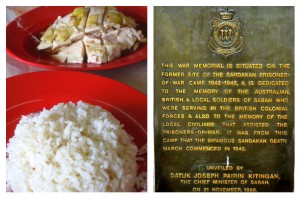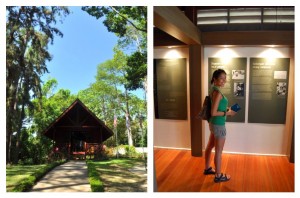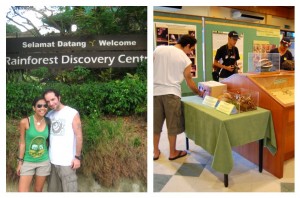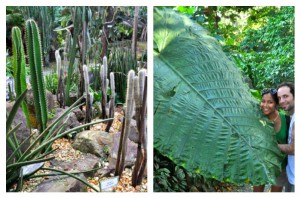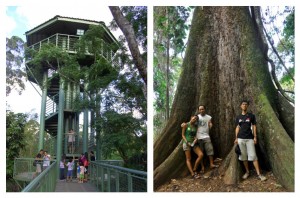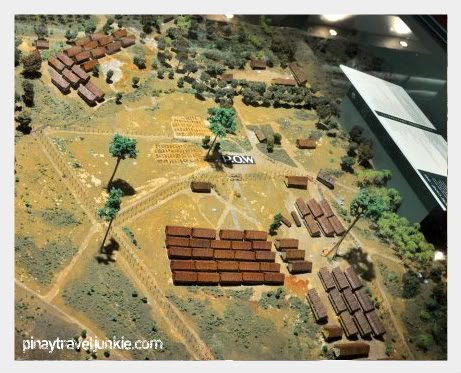
Nature lovers who flock to Sandakan are certainly pumped up. Sure it’s a gateway to ecotourism, but many are not aware that this rainforest has also witnessed a dark past. Nope, I’m not just pertaining to the diminishing number of wildlife. A POW Camp was once set up in Sandakan, and a gruesome “death march” which started here claimed the lives of hundreds of British and Australian prisoners (more than a thousand died in the camp alone).
After visiting the Labuk Bay Proboscis Monkey Sanctuary, I thought we were done for the day. Our Couchsurfing host, Calvin, had a hectic itinerary in mind. We went to a hole in the wall local restaurant for lunch, which only sells steamed chicken and rice – in the middle of Sandakan nowhere.
The place didn’t even have a sign. But boy oh boy, their chicken was so juicy and tasty! And the huge heap of rice was cooked with the water used for steaming the chicken. Just imagine the delish chicken fat drippings (uhm, not for the faint hearted)! We were served complimentary iced house tea. It was Calvin’s treat, and he didn’t mention how much it was worth. I’m guessing the meal can’t be more than RM5.
It was already 2-ish in the afternoon when we finished our late lunch. Calvin drove to our next destination, the Sandakan Memorial Park (after helping us buy kecap manis or thick and sweet soy sauce from the supermarket which was then my obsession).
The Japanese brought more than 2,000 British and Australian POWs (majority of whom were soldiers captured after the fall of Singapore) to Sandakan in 1942 and 1943. They were forced to build a military airstrip. Overworked, starved and beaten.
Late 1944, the airstrip was bombed by the Allies. The Japanese then decided in early 1945 to move the remaining POWs from Sandakan to Ranau, a distance of more than 250 KM. Only six (all Australians) survived out of all those who had been alive in January 1945. Two of which escaped from the second march, and another four escaped from Ranau. They were eventually found by local people, who fed them and helped them stay hidden from the Japanese until they were fetched by the Allied units.
There’s a Commemorative Pavilion within the Sandakan Memorial Park where visitors can read information regarding this historical event. The most moving for me was the testimonies of the 6 survivors. Escaping from the march and the camp is already an arduous task, more so trying to survive in the Borneo jungle. They were all suffering from malnutrition and were affected by diseases (beri beri, malaria, etc.).
I find their escape overwhelmingly inspiring. Hope was the only thing they had.
How to get there:
1. You may hire a cab, about RM30 (up to 4 passengers) from the city center and back.
2. If you rent a car, refer to this map (directions included).
3. Take the bus. Ask for the directions to the station where you can hop on the Batu 8 bus. It should either be in front of Gentingmas Mall or at another station less than 100 meters away. Approaching the airport roundabout, tell the driver or conductor to drop you off the Esso Petrol Station. The Sanadakan Memorial Park is just along Jalan Rimba.
Park is open from 9:00 AM – 5:00 PM, admission is free. Aside from the Commemorative Pavilion, visitors will also find the original excavator and boiler used by the former POW camp within the grounds. The remains of the prisoners by the way do not lie here, they were moved to the Labuan War Cemetery in Pulau Labuan.
Our last stop for the day is the Rainforest Discovery Centre. Calvin, though a Sandakan local, admitted he has never been there before. It’s located within the Kabili-Sepilok Forest Reserve, just 2KM from the Sepilok Orangutan Rehabilitation Centre.
RDC is run by the Sabah Forestry Department, and its primary objective is to raise public awareness of forest conservation. Admission fee for Malaysians: Adults RM5, children 5-17 years old RM2, and children 5 below are free. Admission for non-Malaysians: Adults RM10, children 5-17 years old RM 5, and children 5 below are also free. To get there, read this. If you don’t have a car, just take the minibus to Sepilok and ask the driver to drop you off Sepilok Arboretum Road.
The ticketing counter, Exhibition Hall and Plant Discovery Garden closes at 5PM (open from 8AM). The trails and canopy walkway closes at 10PM (for those who want to trek at night, don’t forget to bring torches!).
The Exhibition Hall gives a quick lesson about the different forest types around the world. It also showcases dried plants, preserved insects and stuffed animals that can be found in Borneo.
The Plant Discovery (one hectare) Garden is a must visit for plant lovers. We’re not one of them but we found it really educational. It was the first time I’ve seen a (black) pepper plant, and also a tongkat ali tree.
Half a day is recommended to fully explore the Rainforest Discovery Centre. We were there for only a couple of hours, so we breezed our way through the different areas. There are several trails to choose from for a leisurely stroll, the longest of which is the Pitta Path which goes on for 2.8KM. We chose the Sepilok Giant Bypass (1KM) and brisk-walked our way to the Sepilok Giant, a humongous tree with buttress roots.
It was already getting dark so we didn’t stay long.
After taking a few photos, we swiftly made our way back. We took the Ridge Trail then the Woodpecker Avenue, and finally ended up at the Lakeside Pavilion. The parking lot is just across. I was exhausted but mighty proud of my achievement. Trekking during the 1st term of pregnancy can be a daunting task. I did get nauseated a few times, but nothing a gulp of water can’t fix.

